
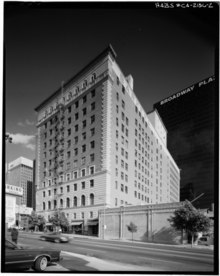


Barker Bros. was a retailer of furniture, home furnishings, and housewares based in Los Angeles, California, United States. Founded as Barker and Mueller in 1880, the business operated under various names through 1992.




Barker Bros. was a retailer of furniture, home furnishings, and housewares based in Los Angeles, California, United States. Founded as Barker and Mueller in 1880, the business operated under various names through 1992.
Obadiah Truax Barker had owned upholstery and mattress shops in Cincinnati, Ohio, and Grand Rapids, Michigan. [1]
In 1880, Barker was visiting Los Angeles on a trip from Colorado Springs to San Jose, California, when he overheard an outraged Otto Müller at a horticultural exhibition complain about the high cost of furnishing his home from the only large furniture store in the city at the time. [1] Barker approached Müller and together they founded a furniture shop on N. Spring Street near the Los Angeles Plaza, called Barker and Mueller.
In 1880, Los Angeles was a town with a population of 11,183. Its population would increase tenfold in the next twenty years, and tenfold again, to over one million, in the 25 years after that. [1]
In 1883, Barker bought out Müller and went into partnership with W. S. Allen, forming Barker & Allen, and moved to the Merced Theatre Building at 8–10 Main Street (pre-1890 numbering), also just off the Los Angeles Plaza. Barker bought out Allen that same year and the firm became O. T. Barker & Sons. [2]
Later the store moved to 3rd & Spring streets at the Stimson Building, Los Angeles' first steel-frame building, where their rent of $1500 was ten times what they had paid on Main Street, a sign of the rapid growth of Los Angeles at the time.[ citation needed ]
Again they moved – the move was done overnight and widely reported – this time to the seven-story Van Nuys building at 716–738 S. Broadway, [1] the area which is now known as the Historic Core, the part of Broadway that was the main commercial street of Los Angeles from around 1910 until World War Two. [2]
On January 25, 1926, [3] the company built and moved into an eleven-story building at 818 W. 7th Street, stretching the full south side block from Flower to Figueroa streets, with 23 acres (1,000,000 sq ft) of floor space. A 1931 article reported that they employed 1,444 people (including 432 women). [2]
The company launched branch stores across Greater Los Angeles and in Bakersfield, with 15 branches by 1955: Hollywood opened in 1927, Long Beach in 1929, plus Glendale, Inglewood, Huntington Park, Santa Monica, Alhambra, Pasadena, Crenshaw, Westwood, Pomona, Van Nuys, Burbank, Santa Ana, Whittier, and Bakersfield, plus a decorator store in Beverly Hills. The company had sales of $30 million at that time, with two-thirds coming from the downtown flagship. [1]
The Downtown flagship closed September 24, 1984. [4] Prisma Capital acquired the company in a leveraged buyout and, having taken on too much debt, caused Barker Bros. to go bankrupt and close in 1992.
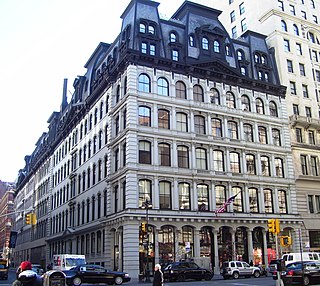
W. & J. Sloane,, was a chain of furniture stores that originated from a luxury furniture and rug store in New York City that catered to the prominent, including the White House and the Breakers, and wealthy, including the Rockefeller, Whitney, and Vanderbilt families.

The Harris Company was a retail corporation, based in San Bernardino, California, that operated a chain of department stores named Harris', all in Southern California. Philip, Arthur, and Herman Harris – nephews of founder Leopold Harris of what was once the large Los Angeles–based chain Harris & Frank – started the company with a small dry goods store in 1905, and the company eventually grew to nine large department stores, with stores in San Bernardino, Riverside, and Kern Counties.

Broadway, until 1890 Fort Street, is a thoroughfare in Los Angeles County, California, United States. The portion of Broadway from 3rd to 9th streets, in the Historic Core of Downtown Los Angeles, was the city's main commercial street from the 1910s until World War II, and is the location of the Broadway Theater and Commercial District, the first and largest historic theater district listed on the National Register of Historic Places (NRHP). With twelve movie palaces located along a six-block stretch of Broadway, it is the only large concentration of movie palaces left in the United States.
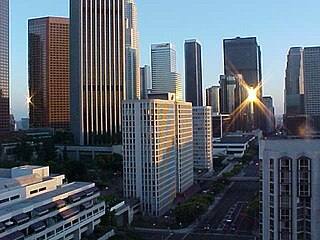
The Financial District is the central business district of Los Angeles along Olive, Grand, Hope, Flower and Figueroa streets from 4th Street to 8th Street. It is south of the Bunker Hill district, west of the Historic Core, north of South Park and east of the Harbor Freeway and Central City West. Like Bunker Hill, the Financial District is home to corporate office skyscrapers, hotels and related services as well as banks, law firms, and real estate companies. However, unlike Bunker Hill which was razed and now consists of buildings constructed since the 1960s, it contains large buildings from the early 20th century, particularly along Seventh Street, once the city's upscale shopping street; the area also attracts visitors as the 7th and Flower area is at the center of the regional Metro rail system and is replete with restaurants, bars, and shopping at two urban malls.
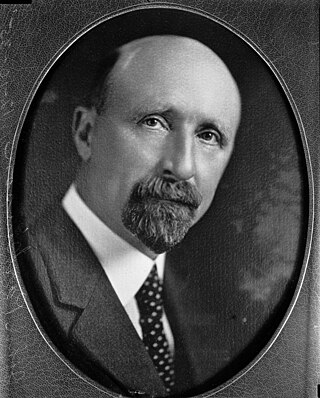
John and Donald Parkinson were a father-and-son architectural firm operating in the Los Angeles area in the early 20th century. They designed and built many of the city's iconic buildings, including Grand Central Market, the Memorial Coliseum and the City Hall.

The Eastern Columbia Building, also known as the Eastern Columbia Lofts, is a thirteen-story Art Deco building designed by Claud Beelman located at 849 S. Broadway in the Broadway Theater District of Downtown Los Angeles. It opened on September 12, 1930, after just nine months of construction. It was built at a cost of $1.25 million as the new headquarters and 39th store for the Eastern-Columbia Department Store, whose component Eastern and Columbia stores were founded by Adolph Sieroty and family. At the time of construction, the City of Los Angeles enforced a height limit of 150 feet (46 m), however the decorative clock tower was granted an exemption, allowing the clock a total height of 264 feet (80 m). J. V. McNeil Company was the general contractor.
The Broadway was a mid-level department store chain headquartered in Los Angeles, California. Founded in 1896 by English-born Arthur Letts Sr., and named after what was once the city's main shopping street, the Broadway became a dominant retailer in Southern California and the Southwest. Its fortunes eventually declined, and Federated Department Stores bought the chain in 1995. In 1996, Broadway stores were either closed or converted into Macy's and Bloomingdales.
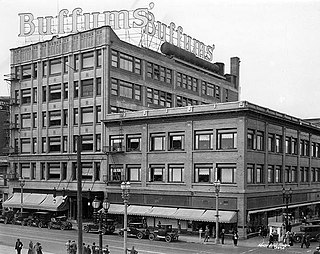
Buffums, originally written as Buffums' with an apostrophe, was a chain of upscale department stores, headquartered in Long Beach, California. The Buffums chain began in 1904, when two brothers from Illinois, Charles A. and Edwin E. Buffum, together with other partners, bought the Schilling Bros., the largest dry goods store in Long Beach, and renamed it The Mercantile Co. The store grew to a large downtown department store, and starting in the 1950s, grew slowly over the years to be a small regional chain of 16 speciality department stores across Southern California at the time of its closure in 1990.
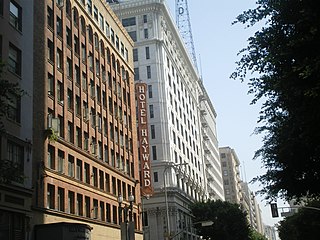
Spring Street in Los Angeles is one of the oldest streets in the city. Along Spring Street in Downtown Los Angeles, from just north of Fourth Street to just south of Seventh Street is the NRHP-listed Spring Street Financial District, nicknamed Wall Street of the West, lined with Beaux Arts buildings and currently experiencing gentrification. This section forms part of the Historic Core district of Downtown, together with portions of Hill, Broadway, Main and Los Angeles streets.

Desmond's was a Los Angeles–based department store, during its existence second only to Harris & Frank as the oldest Los Angeles retail chain, founded in 1862 as a hat shop by Daniel Desmond near the Los Angeles Plaza. The chain as a whole went out of business in 1981 but Desmond's, Inc. continued as a company that went in to other chains to liquidate them. Desmond's stores in Northridge and West Covina were liquidated only in 1986 and survived in Palm Springs into the first years of the 21st century.

Harris & Frank was a clothing retailer and major chain in the history of retail in Southern California, which at its peak had around 40 stores across Southern California and in neighboring states and regions. Its history dates back to a clothing store founded by Leopold Harris in Los Angeles in 1856 near the city's central plaza, only eight years after the city had passed from Mexican to American control. Herman W. Frank joined Harris in partnership 32 years later in 1888.

Coulter's was a department store that originated in Downtown Los Angeles and later moved to the Miracle Mile shopping district in that same city.

Myer Siegel was a Los Angeles–based department store, founded by Myer Siegel (1866–1934), specializing in women's clothing.
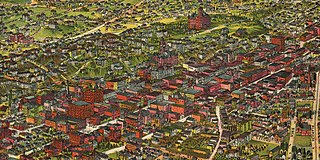
The late-Victorian-era Downtown of Los Angeles in 1880 was centered at the southern end of the Los Angeles Plaza area, and over the next two decades, it extended south and west along Main Street, Spring Street, and Broadway towards Third Street. Most of the 19th-century buildings no longer exist, surviving only in the Plaza area or south of Second Street. The rest were demolished to make way for the Civic Center district with City Hall, numerous courthouses, and other municipal, county, state and federal buildings, and Times Mirror Square. This article covers that area, between the Plaza, 3rd St., Los Angeles St., and Broadway, during the period 1880 through the period of demolition (1920s–1950s).

7th Street is a street in Los Angeles, California running from S. Norton Ave in Mid-Wilshire through Downtown Los Angeles. It goes all the way to the eastern city limits at Indiana Ave., and the border between Boyle Heights, Los Angeles and East Los Angeles.

The Merced Theater is a building in the City of Los Angeles. It was the first theater in the Pueblo of Los Angeles. The theater is located at 420 North Main Street. It is immediately to the south of Pico House, and thus just off Los Angeles Plaza, the city's historic main square. The theater was designated a California Historical Landmark (No.171) on March 6, 1935.

Parmelee-Dohrmann was a Los Angeles–based chain of stores that sold fine china, crystal, glassware, silver, and objects of art.

Retail in Southern California dates back to its first dry goods store that Jonathan Temple opened in 1827 on Calle Principal, when Los Angeles was still a Mexican village. After the American conquest, as the pueblo grew into a small town surpassing 4,000 population in 1860, dry goods stores continued to open, including the forerunners of what would be local chains. Larger retailers moved progressively further south to the 1880s-1890s Central Business District, which was later razed to become the Civic Center. Starting in the mid-1890s, major stores moved ever southward, first onto Broadway around 3rd, then starting in 1905 to Broadway between 4th and 9th, then starting in 1915 westward onto West Seventh Street up to Figueroa. For half a century Broadway and Seventh streets together formed one of America's largest and busiest downtown shopping districts.

J. M. Hale Co., also known as Hales, was a department store Downtown Los Angeles.